
 |
 |
 |
 |
 |
 |
 |
CNC-IUPAC News
IUPAC Announces the 2022 Top Ten Emerging Technologies in Chemistry
The International Union of Pure and Applied Chemistry (IUPAC) has released the results of the search for the 2022 Top Ten Emerging Technologies in Chemistry. The goal of this project is to showcase the transformative value of chemistry and to inform the general public on the potential of the chemical sciences to foster the well-being of Society and the sustainability of our planet. The Jury* - an international group of objective experts with a varied and broad range of expertise - reviewed and discussed the diverse pool of nominations of emerging technologies submitted by researchers from around the globe and selected the final top ten. These technologies are defined as scientific advances in between a discovery and a fully-commercialized idea, having outstanding potential to open new opportunities in chemistry, sustainability, and beyond. The 2022 finalists are posted on the IUPAC website https://iupac.org/iupac-2022-top-ten/.
Nominations for the 2023 technologies are now being accepted through March 31, 2023. For more information on the search for the 2023 Top Ten Emerging Technologies in Chemistry go to: https://iupac.org/the-top-ten-emerging-technologies-in-chemistry-call-for-proposals--for-2023/.

Canada's Global Breakfast Events: "Empowering Diversity in Science" #GWB2021
IUPAC started the Global Women's Breakfast in 2019 as part of the #IUPAC100 celebrations. In 2019, there were 10 events across Canada and in 2020, there were over 20 Canadian breakfasts. This year breakfasts are being hosted around the world on February 9 and of course due to the pandemic, many of these will be virtual meet-ups. Do not let this discourage you! More information is available on the website at https://iupac.org/gwb/. Organizers can register their event on this central site (https://iupac.org/gwb/registration/) and access a resource page with logos, ideas for programming etc. Breakfasts (or just a virtual chat over coffee) can be small or big (2 to 100+ attendees), informal, for professionals and/or students. Last year, they were hosted in work places, high schools and universities. They can also be hosted on a later date (e.g. the weekend). The format is very flexible and inclusive (anyone with an interest in EDI in the workplace or education is invited). Please share experiences on social media (facebook, twitter, instagram) using #GWB2021 so others can see what is happening in the Canadian chemistry community. Contact Dr. Kerton, Memorial University, if you have any questions. E-mail:fkerton@mun.ca
Just Launched another Legacy from 2019!
The legacy activity from the PT Chemists, called ChemVoices, has just gone live! Webinars past and near future are posted.
https://chemvoices.org/ https://iupac.org/chemvoices/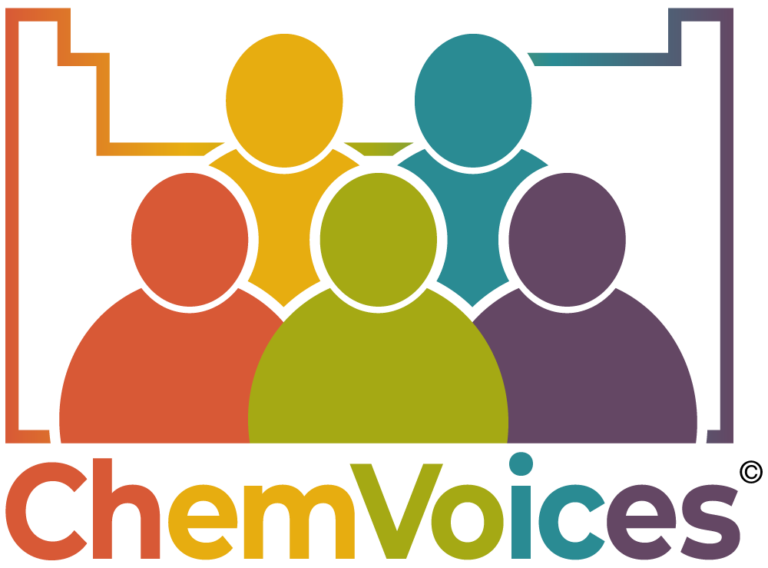
A New Periodic Table Challenge for 2020
Following the tremendous success of the Periodic Table Challenge in 2019, IUPAC is relaunching a whole new PT Challenge!
Here's where it'll be: www.iupac.org/periodic-table-challenge 2020 Challenge will run all year!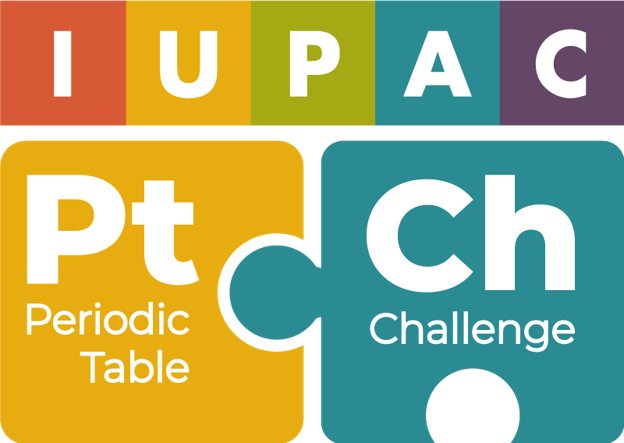
Canada’s Global Breakfast Events: "Building bonds to create future leaders" #GWB2020
IUPAC started the Global Women's Breakfast in 2019 as part of the #IUPAC100 celebrations and there were 10 events across Canada. This year breakfasts are being hosted around the world on February 12. More information is available on the website at https://iupac.org/event/iupac-global-breakfast/. Organizers can register their event on this central site from Jan 20 and access a resource page with logos, ideas for programming (e.g. panel discussions, speed networking, games/challenges) etc. Breakfasts can be small or big (5 to 100+ attendees), informal, for professionals and/or students. Some are run as 'pot lucks' whereas others are catered. Last year, they were hosted in work places, high schools and universities. They do not even need to be a breakfast - some people host a coffee/tea time in the afternoon or a lunch, and they can also be hosted on a later date (e.g. the weekend). The format is very flexible and inclusive (anyone with an interest in EDI in the workplace or education is invited). Please share experiences on social media (facebook, twitter, instagram) using #GWB2020 so others can see what is happening in the Canadian chemistry community. Contact Dr. Kerton, Memorial University, if you have any questions. E-mail:fkerton@mun.ca
Canada’s Global Breakfast Events: Empowering Women in Chemistry
Organizer: Working for Inclusivity in Chemistry group, University of Alberta
Contact: Meagan Oakley (moakley@ualberta.ca)
Venue: 10912 88 Ave NW, Edmonton, AB T6G 0Z1
https://ualbertawic.wordpress.com/iupac-global-womens-breakfast/
Organizer: University of Calgary
Contact: Dr. Belinda Heyne (bjmheyne@ucalgary.ca)
Venue: Central Library in Calgary, 800 3 St SE, Calgary, AB T2G 0E7.
Organizer: Saint Mary's University
Contact: Prof. Christa Brosseau (christa.brosseau@smu.ca)
Venue: Saint Mary's University, 923 Robie Street, Halifax, NS B3H 3C3.
Organizer: Western University
Contact: Ms. Rebecca Yardley (ryardley@uwo.ca)
Venue: Western University North Campus Building - Room 270, 1151 Richmond Street, London, ON N6A 3K7.
Organizer: CNC-IUPAC & NRC Canada
Contact: Dr. Shan Zou (shan.zou@nrc-cnrc.gc.ca)
Venue: NRC, 100 Sussex Drive, Ottawa, K1N 5A2
http://outreach-diffusion.nrc-cnrc.gc.ca/T/OFSYS/SM2/249/2/S/F/6391/796055/xDqg7sSr/742803
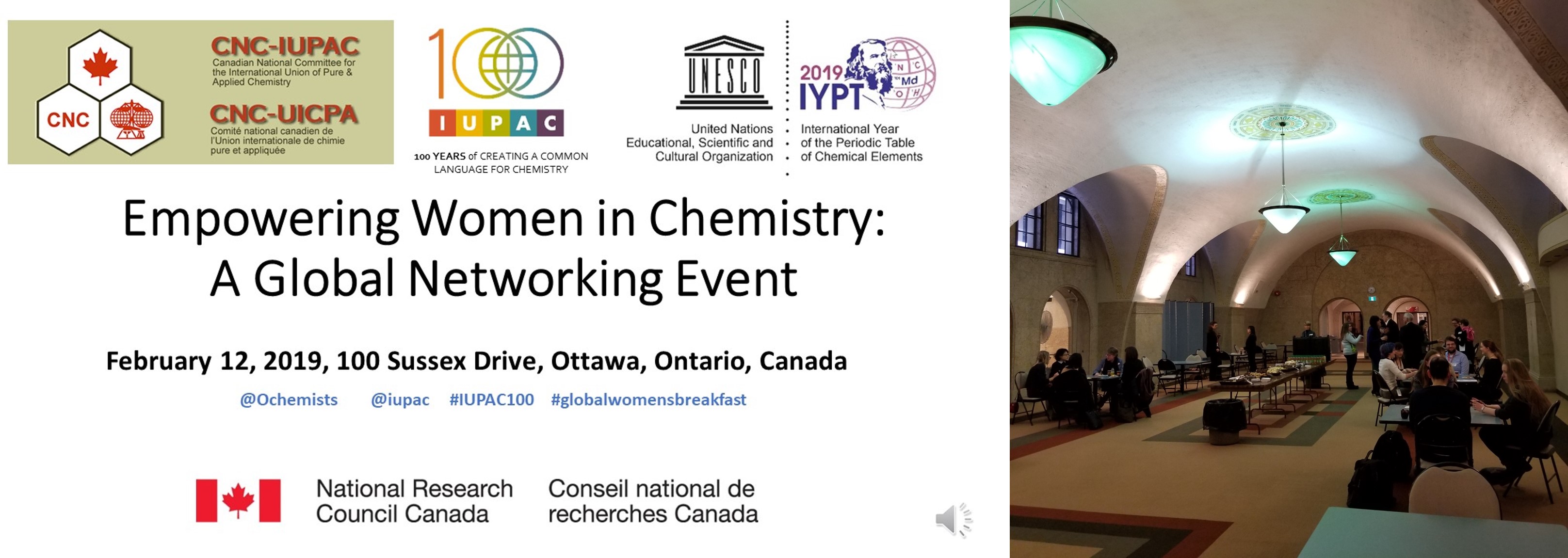

Event recap: Empowering women in chemistry through mentoring and networking A panel discussion on the important role mentorship and networking play in empowering women to succeed in their scientific careers was held on Tuesday, February 12th, in Ottawa, with leading chemists from academia and government. It was hosted by the National Research Council of Canada (NRC) and the Canadian National Committee for the International Union of Pure & Applied Chemistry (CNC-IUPAC) to commemorate the 100th anniversary of IUPAC. Keynote speaker Dr. Geneviève Tanguay, NRC’s Vice-President of Emerging Technologies, kicked off the conversation by sharing her personal stories from her time as a student scientist. Afterwards, moderator Dr. Danial Wayner, NRC’s Departmental Science Advisor and Chief Science Officer, launched the discussion with panellists: Prof. Deryn Fogg, Department of Chemistry and Biomolecular Sciences at the University of Ottawa; Dr. Donna Kirkwood, Chief Scientist at Natural Resources Canada; Prof. Maria DeRosa, Department of Chemistry at Carleton University; and Dr. Michael Schuurman, Group Leader and Research Officer at the NRC. The panel discussed questions regarding their mentors, how they were influenced, and which attributes to look for in a good advisor. In case you missed it, watch the entire discussion at https://bit.ly/2I35YPQ.
Organizer: University of Saskatchewan-Women in Chemistry
Contact: Josseline Ramos (womeninchemsask@gmail.com)
Venue: Room Thorvaldson 159, University of Saskatchewan.
Organizer: Memorial University of Newfoundland
Contact: Juliana Vidal (jlvidal@mun.ca)
Venue: Room C-4019, Chemistry Building, Memorial University of Newfoundland, 230 Elizabeth Ave, St. John's, NL A1C 5S7
Organizer: Cape Breton University
Contact: Dr. Stephanie MacQuarrie (stephanie_macquarrie@cbu.ca)
Venue: CS 101 at Cape Breton University, Sydney, Nova Scotia
http://www.macquarrieresearch.ca/island-wise
Organizer: Women in Chemistry Toronto, ChemClub, CPS GSA, Chemical Institute of Canada, University of Toronto Chemistry
Contact: Women in Chemistry Toronto (womeninchemto@gmail.com)
Venue: Lash Miller Chemical Laboratories, 80 St. George Street, Davenport Atrium, Toronto, ON M5S 3H6
https://iupac.org/100/wp-content/uploads/sites/2/2019/02/IUPACBfast_UTStG.pdf
Organizer: Women in Chemistry, University of Manitoba
Contact: Prof. Jennifer van Wijngaarden (wic.manitoba@gmail.com)
Venue: Sciences and Technology Library (Main floor), University of Manitoba, Winnipeg
IUPAC100 Periodic Table Challenge
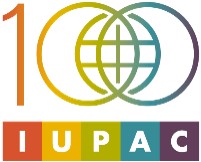
The year 2019 marks the 100th anniversary of IUPAC and also the 150th anniversary of the development of the Periodic Law of the Elements independently by Dmitri Mendeleev and Lothar Meyer. To celebrate these anniversaries, IUPAC is hosting an online challenge about the Periodic Table of the Elements aimed at a global audience of young students. Our goal is to reach players from every country. The challenge runs from January 2019 and will be available all year until the end of 2019.
The IUPAC Periodic Table Challenge will present you with 15 randomly chosen multiple-choice questions about the elements. To play, you will be asked to choose an element as avatar. Your score will go towards this element in the leaderboard. For details, see here.
When you finish the challenge, you will be asked to provide your name and email so we can keep track of your achievements. The Challenge is in English and if you have difficulties in understanding some of the questions, please copy the text and use online translation tools to help.
Periodic Table of Younger Chemists
 Dr. Erin McConnell
Dr. Erin McConnell
Postdoctoral Fellow
McMaster University
Element: Helium
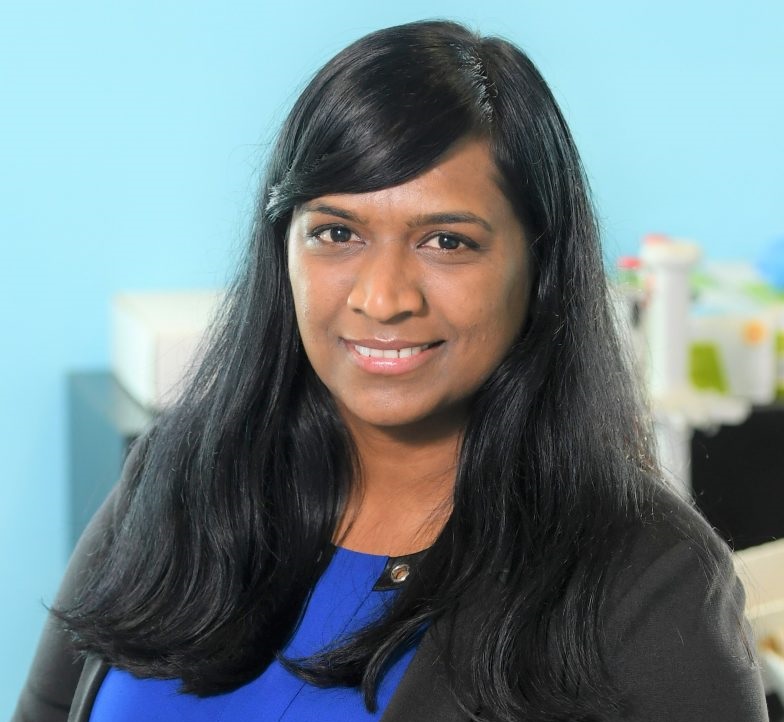 Dr. Mita Dasog
Dr. Mita Dasog
Assistant Professor
Dalhousie University
Element: Silicon
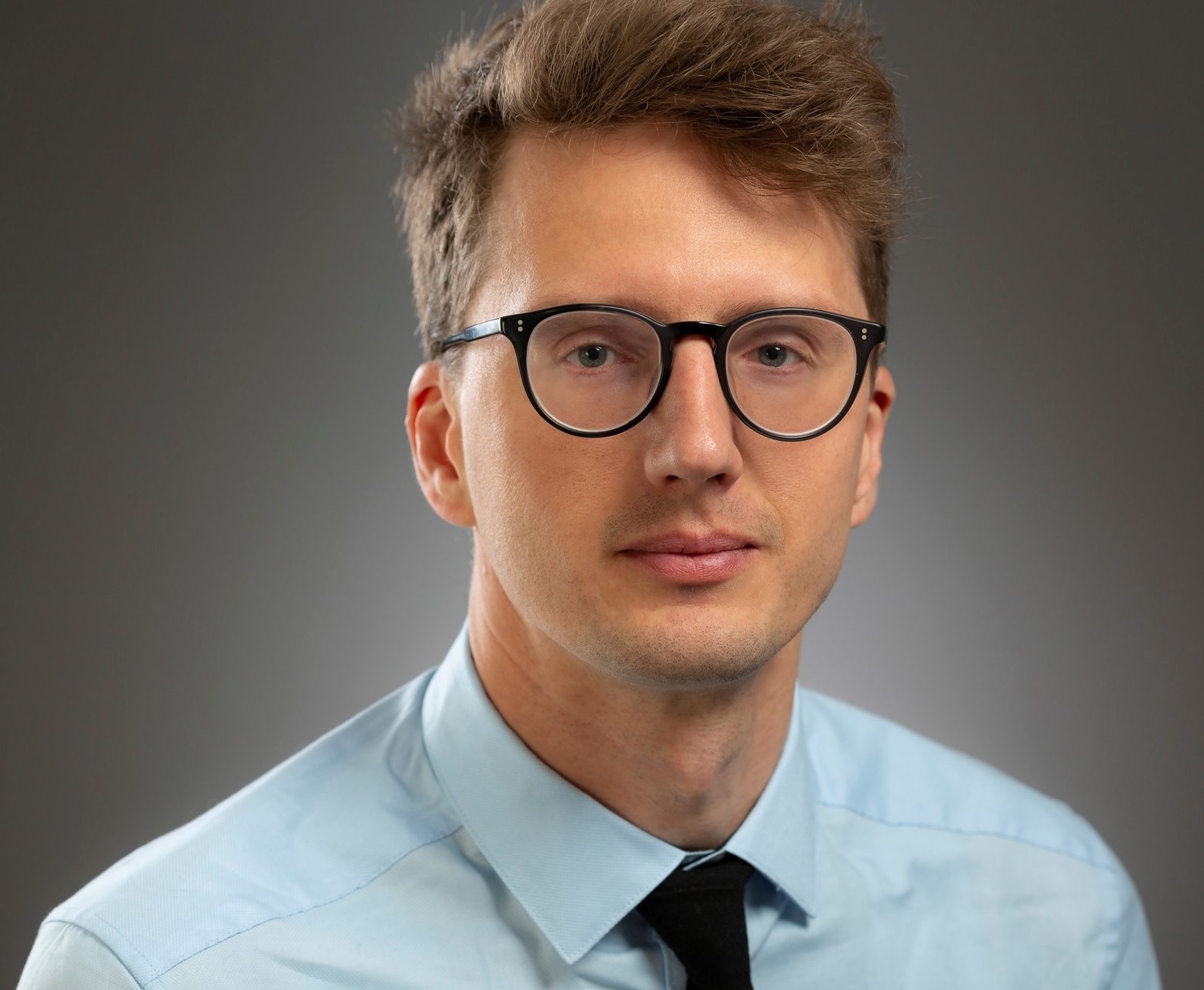 Dr. Juris Meija
Dr. Juris Meija
Research Officer
National Research Council Canada
Element: Osmium
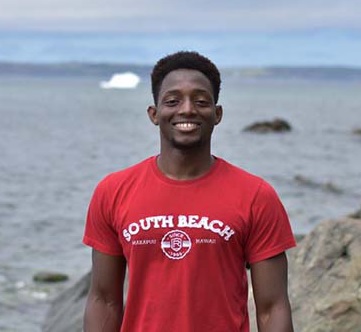
Mr. Ernest Awoonor-Williams
Ph.D. Candidate
Memorial University
Element: Zinc

Ms. Kelly L. Summers
Ph.D. Candidate
University of Saskatchewan
Element: Copper
Empowering Women in Chemistry: A Global Networking Event
As part of the IUPAC100 celebration, IUPAC invites women chemists and students from around the world to celebrate the achievements of women in chemistry on February 12, 2019. CNC-IUPAC invites groups in Canada to organize breakfast networking events and to connect on that day with other groups around Canada and the world as a way to strengthen the bonds between women in chemistry.
Individual breakfast celebrations will be asked to announce the opening and closing of their event by posting a short video to Twitter or Instagram with the hashtags #IUPAC100 and #globalwomensbreakfast. As groups announce themselves, their locations will light up on the global breakfast map creating a continuous wave around the globe. Individuals attending the events are encouraged to post photos, videos and/or blog posts.
Be creative! Make your event memorable and fun!
Let us know if you are interested in being part of the celebrations!
Dr. Shan Zou (Secretary of CNC-IUPAC shan.zou@nrc-cnrc.gc.ca)
.

2019 International Year of the Periodic Table of Chemical Elements (IYPT 2019)
To celebrate the 2019 International Year of the Periodic Table of Chemical Elements (IYPT 2019), University of Waterloo is leading a collaborative project: deconstruct the periodic table into the years the elements were discovered.
The goal is to have chemistry students from around the world join together to create an original and imaginative version of the Timeline of Elements focused on their discovery.
Form application opened from May 15 to August 7, 2018.
Check here for more details.
To know more about IYPT 2019, click here.
CNC-IUPAC Travel Awards for 2019, check here for more details.
Canadian National Committee for IUPAC and Canadian Society for Chemistry is awarded to host the 51st IUPAC General Assembly and the 48th World Chemistry Congress in Montreal from August 13 to August 20, 2021.
Please read details following this link: IUPAC_2021 or IUPAC 2021 and 2023.
The 5 mins presentation file at the IUPAC Council meeting can be viewed here.
IUPAC Names of the Four New Elements: 113, 115, 117 and 118
The 7th period of the periodic table of elements is complete!
Elements 113, 115, 117, and 118 are now formally named nihonium (Nh), moscovium (Mc), tennessine (Ts), and oganesson (Og)
On 28 November 2016, the International Union of Pure and Applied Chemistry (IUPAC) approved the names and symbols for four elements: nihonium (Nh), moscovium (Mc), tennessine (Ts), and oganesson (Og), respectively for element 113, 115, 117, and 118.
Following a 5-month period of public review, the names earlier proposed by the discoverers have been approved by the IUPAC Bureau. The following names and symbols are officially assigned:
Nihonium and symbol Nh, for the element 113,
Moscovium and symbol Mc, for the element 115,
Tennessine and symbol Ts, for the element 117, and
Oganesson and symbol Og, for the element 118.
In concordance with and following the earlier reports that the claims for discovery of these elements have been fulfilled [1,2], the discoverers have been invited to propose names. Keeping with tradition, the newly discovered elements have been named after a place or geographical region, or a scientist. The ending of the names also reflects and maintains historical and chemical consistency: “-ium” for elements 113 and 115 and as for all new elements of groups 1 to 16, “-ine” for element 117 and belonging to group 17 and “-on” for element 118 element belonging to group 18.[3] The recommendations will be published in the IUPAC journal Pure and Applied Chemistry (http://dx.doi.org/10.1515/pac-2016-0501). For further information please see: www.iupac.org/iupac-announces-the-names-of-the-elements-113-115-117-and-118.
The name nihonium with the symbol Nh for element 113 was proposed by the discoverers at RIKEN Nishina Center for Accelerator-Based Science (Japan); the name came from Nihon which is one of the two ways to say “Japan” in Japanese, and literally mean “the Land of Rising Sun”.
Moscovium with the symbol Mc for element 115 and tennessine with the symbol Ts for element 117 were proposed by the discoverers at the Joint Institute for Nuclear Research, Dubna (Russia), Oak Ridge National Laboratory (USA), Vanderbilt University (USA) and Lawrence Livermore National Laboratory (USA). Both are in line with tradition honoring a place or geographical region. Moscovium is in recognition of the Moscow region and honors the ancient Russian land that is the home of the Joint Institute for Nuclear Research, where the discovery experiments were conducted using the Dubna Gas-Filled Recoil Separator in combination with the heavy ion accelerator capabilities of the Flerov Laboratory of Nuclear Reactions. Tennessine is in recognition of the contribution of the Tennessee region of the United States, including Oak Ridge National Laboratory, Vanderbilt University, and the University of Tennessee at Knoxville, to superheavy element research.
Lastly, and in line with the tradition of honoring a scientist, the name oganesson and symbol Og for element 118 was proposed by the collaborating teams of discoverers at the Joint Institute for Nuclear Research, Dubna (Russia) and Lawrence Livermore National Laboratory (USA) and recognizes Professor Yuri Oganessian (born 1933) for his pioneering contributions to transactinoid elements research. His many achievements include the discovery of superheavy elements and significant advances in the nuclear physics of superheavy nuclei including experimental evidence for the “island of stability”.
Comments from the general public, during the 5 month period were many. Apart from many full agreements, comments were received suggesting other names, in some cases accompanied by petitions from large groups of people. However, these suggestions could not be accepted, given the fact that under the current guidelines only the discoverers have the right to propose names and symbols. Questions were also received about pronunciation of the names and the translations into other languages. Members of the chemistry community also raised the concern that Ts is one of the two commonly used abbreviations for the tosyl group. Recognizing however that many two-letter abbreviations have multiple meanings —even in chemistry, and for example Ac and Pr— the conclusion was made that the context in which the symbols are used, makes the meaning unambiguous.
“Overall, it was a real pleasure to realize that so many people are interested in the naming of the new elements, including high-school students, making essays about possible names and telling how proud they were to have been able to participate in the discussions,” said Professor Jan Reedijk, President of the Inorganic Chemistry Division. He added “It is a long process from initial discovery to the final naming, and IUPAC is thankful for the cooperation of everyone involved. For now, we can all cherish our periodic table completed down to the seventh row.”
“The names of the new elements reflect the realities of our present time,” said IUPAC President Professor Natalia Tarasova &ldquouniversality of science, honoring places from three continents, where the elements have been discovered—Japan, Russia, the United States—and the pivotal role of human capital in the development of science, honoring an outstanding scientist—Professor Yuri Oganessian.”
The exploration of new elements continues, and scientists are searching for elements beyond the seventh row of the periodic table. IUPAC and the International Union of Pure and Applied Physics (IUPAP) are establishing a new joint working group whose task will be to examine the criteria used to verify claims for the discovery of new elements.
References:
[1] P.J. Karol, R.C. Barber, B.M. Sherrill, E. Vardaci, T. Yamazaki, Pure Appl. Chem. 88 (2016) 139; http://dx.doi.org/10.1515/pac-2015-0502
[2] P.J. Karol, R. C. Barber, B. M. Sherrill, E. Vardaci, T. Yamazaki, Pure Appl. Chem. 88 (2016) 155; http://dx.doi.org/10.1515/pac-2015-0501
[3] W.H. Koppenol, J. Corish, J. Garcia-Martinez, J. Meija, J. Reedijk, Pure Appl. Chem. 88 (2016) 401; online 21 Apr 2016; http://dx.doi.org/10.1515/pac-2015-0802
For further information, contact Dr. Lynn M. Soby, Executive Director, IUPAC, at executivedirector@iupac.org or lsoby@iupac.org